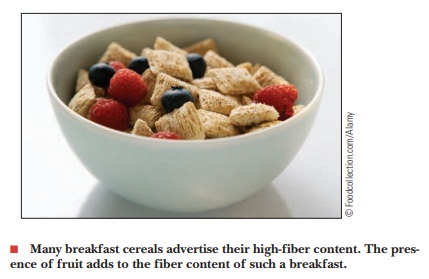Chapter: Biochemistry: Carbohydrates
Why Is Dietary Fiber So Good for You?
Why Is Dietary
Fiber So Good for You?
Fiber in the diet is colloquially called roughage. It is
principally made of complex carbohydrates, may have some protein components,
and is moderately to fully insoluble. The health benefits of fiber are just
beginning to be fully realized. We have known for a long time that roughage
stimulates peristaltic action and thus helps move the digested food through the
intestines, decreasing the transit time through the gut.
Potentially toxic substances in food and in bile fluid bind to fiber and are exported from the body, thus preventing them from damaging the lower intestine or being reabsorbed there.
Statistical evidence indicates that high fiber also reduces colon
and other cancers, precisely because fiber binds suspected car-cinogens. It is
also plausible that the benefit is due to a lack of other items in the
high-fiber diet. People on high-fiber diets also tend to take in less fat and
fewer calories. Any difference in heart disease or cancer may be due to these
other differences.
There has been much publicity about fiber in the diet reduc-ing
cholesterol. Fiber does bind cholesterol, and it certainly causes some decrease
in the amount in the blood. The reduction, expressed as a percentage, is higher
in cases in which the original level of cholesterol is higher. There is,
however, no definitive evi-dence that lowering cholesterol via the ingestion of
fiber results in less heart disease.

Fiber comes in two forms: soluble and insoluble. The most common
insoluble fiber is cellulose, which is found in lettuce, carrots, bean sprouts,
celery, brown rice, most other vegetables, many fruit skins, and pumpernickel
bread. Insoluble fiber binds various molecules but otherwise merely forms bulk
in the lower intestine. Soluble fibers include amylopectin and other pectins,
as well as complex starches. Uncooked and mildly processed foods contain a
higher proportion of this type of fiber.
Because of increased surface area, these fibers seem to be more
beneficial. Good sources include bran (especially oat bran), barley, and fresh
fruits (with skin), brussels sprouts, potatoes with skin, beans, and zucchini.
Soluble fiber binds water very well, increasing satiety by helping to fill the
stomach.
Related Topics